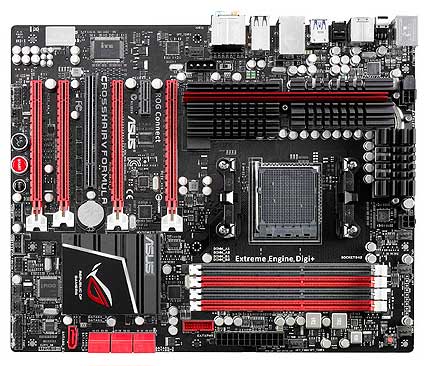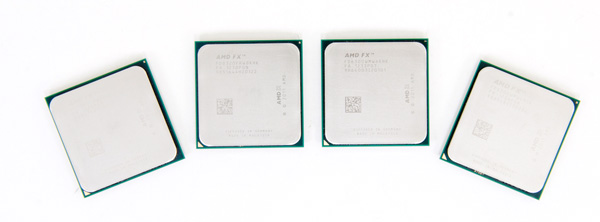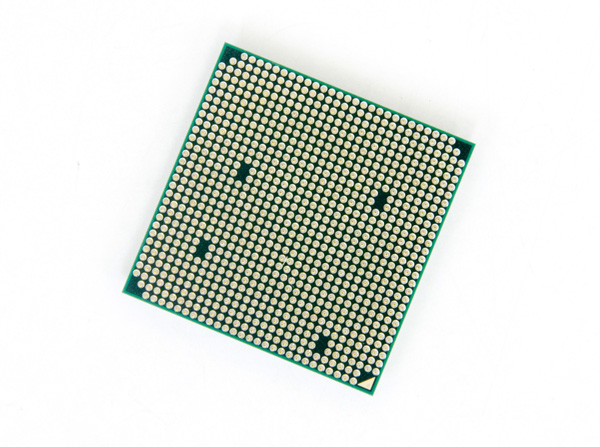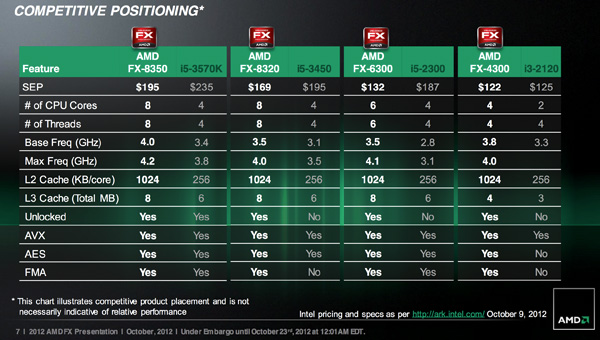The Vishera Review: AMD FX-8350, FX-8320, FX-6300 and FX-4300 Tested
by Anand Lal Shimpi on October 23, 2012 12:00 AM ESTLast year's launch of AMD's FX processors was honestly disappointing. The Bulldozer CPU cores that were bundled into each Zambezi chip were hardly power efficient and in many areas couldn't significantly outperform AMD's previous generation platform. Look beyond the direct AMD comparison and the situation looked even worse. In our conclusion to last year's FX-8150 review I wrote the following:
"Single threaded performance is my biggest concern, and compared to Sandy Bridge there's a good 40-50% advantage the i5 2500K enjoys over the FX-8150. My hope is that future derivatives of the FX processor (perhaps based on Piledriver) will boast much more aggressive Turbo Core frequencies, which would do wonders at eating into that advantage."
The performance advantage that Intel enjoyed at the time was beyond what could be erased by a single generation. To make matters worse, before AMD could rev Bulldozer, Intel already began shipping Ivy Bridge - a part that not only increased performance but decreased power consumption as well. It's been a rough road for AMD over these past few years, but you have to give credit where it's due: we haven't seen AMD executing this consistently in quite a while. As promised we've now had multiple generations of each platform ship from AMD. Brazos had a mild update, Llano paved the way for Trinity which is now shipping, and around a year after Zambezi's launch we have Vishera: the Piledriver based AMD FX successor.
At a high level, Vishera swaps out the Bulldozer cores from Zambezi and replaces them with Piledriver. This is the same CPU core that is used in Trinity, but it's optimized for a very different purpose here in Vishera. While Trinity had to worry about working nicely in a laptop, Vishera is strictly a high-end desktop/workstation part. There's no on-die graphics for starters. Clock speeds and TDPs are also up compared to Trinity.
| CPU Specification Comparison | ||||||||
| CPU | Manufacturing Process | Cores | Transistor Count | Die Size | ||||
| AMD Vishera 8C | 32nm | 8 | 1.2B | 315mm2 | ||||
| AMD Zambezi 8C | 32nm | 8 | 1.2B | 315mm2 | ||||
| Intel Ivy Bridge 4C | 22nm | 4 | 1.4B | 160mm2 | ||||
| Intel Sandy Bridge E (6C) | 32nm | 6 | 2.27B | 435mm2 | ||||
| Intel Sandy Bridge E (4C) | 32nm | 4 | 1.27B | 294mm2 | ||||
| Intel Sandy Bridge 4C | 32nm | 4 | 1.16B | 216mm2 | ||||
| Intel Lynnfield 4C | 45nm | 4 | 774M | 296mm2 | ||||
| Intel Sandy Bridge 2C (GT1) | 32nm | 2 | 504M | 131mm2 | ||||
| Intel Sandy Bridge 2C (GT2) | 32nm | 2 | 624M | 149mm2 | ||||
Vishera is still built on the same 32nm GlobalFoundries SOI process as Zambezi, which means there isn't much room for additional architectural complexity without ballooning die area, and not a whole lot of hope for significantly decreasing power consumption. As a fabless semiconductor manufacturer, AMD is now at GF's mercy when it comes to moving process technology forward. It simply has to make 32nm work for now. Piledriver is a light evolution over Bulldozer, so there's actually no substantial increase in die area compared to the previous generation. Cache sizes remain the same as well, which keeps everything roughly the same. These chips are obviously much larger than Intel's 22nm Ivy Bridge parts, but Intel has a full node advantage there which enables that.
Piledriver is a bit more power efficient than Bulldozer, which enables AMD to drive Vishera's frequency up while remaining in the same thermal envelope as Zambezi. The new lineup is in the table below:
| CPU Specification Comparison | ||||||||||
| Processor | Codename | Cores | Clock Speed | Max Turbo | L2/L3 Cache | TDP | Price | |||
| AMD FX-8350 | Vishera | 8 | 4.0GHz | 4.2GHz | 8MB/8MB | 125W | $199 | |||
| AMD FX-8150 | Zambezi | 8 | 3.6GHz | 4.2GHz | 8MB/8MB | 125W | $183 | |||
| AMD FX-8320 | Vishera | 8 | 3.5GHz | 4.0GHz | 8MB/8MB | 125W | $169 | |||
| AMD FX-8120 | Zambezi | 8 | 3.1GHz | 4.0GHz | 8MB/8MB | 125W | $153 | |||
| AMD FX-6300 | Vishera | 6 | 3.5GHz | 4.1GHz | 6MB/8MB | 95W | $132 | |||
| AMD FX-6100 | Zambezi | 6 | 3.3GHz | 3.9GHz | 6MB/8MB | 95W | $112 | |||
| AMD FX-4300 | Vishera | 4 | 3.8GHz | 4.0GHz | 4MB/4MB | 95W | $122 | |||
| AMD FX-4100 | Zambezi | 4 | 3.6GHz | 3.8GHz | 4MB/4MB | 95W | $101 | |||
The table above says it all. TDPs haven't changed, cache sizes haven't changed and neither have core counts. Across the board Vishera ships at higher base frequencies than the equivalent Zambezi part, but without increasing max turbo frequency (in the case of the 8-core parts). The 6 and 4 core versions get boosts to both sides, without increasing TDP. In our Trinity notebook review I called the new CPU core Bulldozed Tuned. The table above supports that characterization.
It's also important to note that AMD's pricing this time around is far more sensible. While the FX-8150 debuted at $245, the 8350 drops that price to $199 putting it around $40 less than the Core i5 3570K. The chart below shows where AMD expects all of these CPUs to do battle:
AMD's targets are similar to what they were last time: Intel's Core i5 and below. All of the FX processors remain unlocked and ship fully featured with hardware AES acceleration enabled. Most Socket-AM3+ motherboards on the market today should support the new parts with nothing more than a BIOS update. In fact, I used the same ASUS Crosshair V Formula motherboard I used last year (with a much newer BIOS) for today's review:

The Test
For more comparisons be sure to check out our performance database: Bench.
| Motherboard: | ASUS Maximus V Gene (Intel Z77) ASUS Crosshair V Formula (AMD 990FX) |
| Hard Disk: | Intel X25-M SSD (80GB) Crucial RealSSD C300 OCZ Agility 3 (240GB) Samsung SSD 830 (512GB) |
| Memory: | 4 x 4GB G.Skill Ripjaws X DDR3-1600 9-9-9-20 |
| Video Card: | ATI Radeon HD 5870 (Windows 7) NVIDIA GeForce GTX 680 (Windows 8) |
| Desktop Resolution: | 1920 x 1200 |
| OS: | Windows 7 x64/Windows 8 Pro x64 |













250 Comments
View All Comments
CeriseCogburn - Tuesday, October 30, 2012 - link
Problem is you have that attitude more than once, and then you're into a slow degrading slop with lost performance.So, why do we get these arguments from amd fanboys ?
Obviously you purchased the 6950 and decided you needed every last drop of juice from it, and there you go, oc'ed to 6970...
So on the one hand you've takena safe and sufficient card and hammered the piss out of it for a few more frames you cannot notice, as you do tell us you cannot notice them, and then you take your cannot notice them argument, and claim that's why your amd cpu is so great... and intel is not needed.
I see you did that without even noticing. You totally freaking contradicted yourself, completely.
Look, go ahead and buy amd and be a fanboy, I say more power to you, just DON'T type up crap talking points with 100% absolute contradiction, plussing them blatantly in amd's favor, and expect I'l just suck em down like freaking koolaid.
DO NOT.
Intel is desired for the very same reason, you the amd fanboy, bought the 6950 and have it OC'ed to 6970 speeds.
Sorry bub, nice try, till you ate both your own shoes.
Ellimist - Tuesday, October 23, 2012 - link
I would also like to see virtualisation in benchmarks as well. Multi core processors should lend to some interesting results in these sort of benchmarks.Good Review btw. Keep up the good work.
silverblue - Tuesday, October 23, 2012 - link
I think that's Johan's domain; expect him to do so when he looks at the new server-based models.HW_mee - Tuesday, October 23, 2012 - link
The 8320 is a 125W partCeriseCogburn - Tuesday, October 30, 2012 - link
LOL - oh dats not much powa ! All da amd fanboys don't care about power or saving the earth, they never cared, they never are worried, nor have they ever been worried about housefires...All that hate toward JenHsung and all those years of destroying the earth rage against nVidia, that actually happened on another planet in an alternate universe.
gamoniac - Tuesday, October 23, 2012 - link
Anand, while enjoying your Vishera review, upon loading a page, the ad on your page took over my browser and navigated to a fishy looking "You are today's 100,000th visitor!" site. I know AT contracts out the ad part, but I thought you might be interested in knowing what happened. Here is a screenshot of what I experienced -- http://i45.tinypic.com/2aigegx.jpgGood reading, as always.
Ryan Smith - Tuesday, October 23, 2012 - link
Thank you for reporting that. I'll see if I can track down the source and get them removed.artk2219 - Tuesday, October 23, 2012 - link
Thanks for the review and all of the time that went into it! It looks like I can finally start recommending something that isn't a Phenom II from AMD. Even though I personally love AMD and haven't used an intel chip since the P3 coppermine days, I couldn't recommend anything from AMD to anyone else this past year with a clear conscience, at least if it wasn't a stand alone CPU upgrade. But from the tests that I could find that compared the fx 4300 to the i3 3220 it looks like its mostly a wash between them, well other than power usage and thermals that is, so that was looking great! Is there any chance of a stand alone review in the future comparing the two? It looks like the 8350 performs about like a 2500K which is also awesome, unfortunately it's at least a year late to the party :(. This does however give me great hope for Steamroller, the only issue I had with the article is with the games selection (too few and too intel biased in the titles (SC2 and WOW)), might there be a more in depth review on that in the future as well? Thanks again for the review though!CeriseCogburn - Tuesday, October 30, 2012 - link
Wow hi there. Glad to meet you, an amd fanboy with the glimmers of a conscience.Now, don't forget the i2500K Oc's from 3200 right on up to 4500 (and beyond) on stock voltage and crap stock fan, so it actually SMOKES the daylights out of this fishy vishy.
Just thought I'd mention that.
SilthDraeth - Monday, October 22, 2012 - link
That was weird, was reading this article about Vishera and it got pulled in the middle of me reading it.